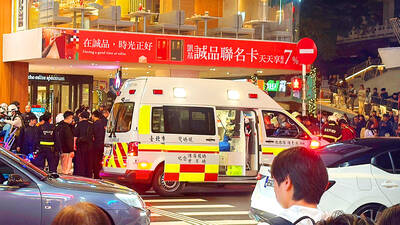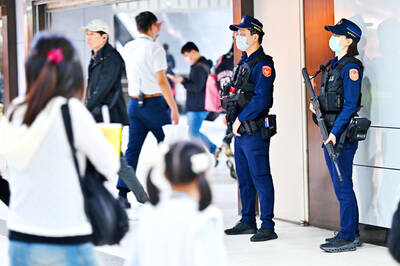Violence raged in the administrative heart of Cairo yesterday as troops and police deployed in force after clashes with protesters against continued military rule left eight people dead.
Smoke billowed over Tahrir Square, the iconic focus of the protest movement that overthrew former Egyptian president Hosni Mubarak in February, after two nearby government offices caught fire, a correspondent said.
Demonstrators pelted security forces with rocks and Molotov cocktails as they fought running battles in the streets around the square and an adjacent bridge across the River Nile.
Egyptian Prime Minister Kamal al-Ganzouri raised tensions by accusing the protesters of being counterrevolutionaries and denying that security forces had opened fire as they broke up a sit-in outside the nearby Cabinet office launched against his nomination last month.
Troops and police moved to retake control of the area around the office early yesterday, erecting razorwire barriers on access roads.
However, after a few hours of calm, new clashes erupted between demonstrators and security forces, overshadowing the count in the second phase of the first general election since Mubarak’s ouster.
Friday’s fighting, which raged from dawn well into the night, was the bloodiest since five days of protests last month killed more than 40 people just ahead of the first round of the phased parliamentary election.
Adel Adawi, an aide to the health minister, told state news agency MENA yesterday that the casualty toll had reached eight dead and 299 wounded.
“The people demand the execution of the field marshal,” the demonstrators chanted in reference to Hussein Tantawi, the head of the Supreme Council of the Armed Forces (SCAF), which took over following Mubarak’s ouster.
Tantawi, in a gesture apparently aimed at mollifying the protesters, ordered the treatment of all civilians wounded at military hospitals, which are usually better equipped than civilian counterparts, state television reported.
Pictures of a military policeman grabbing a woman by her hair and of another looming over a sobbing elderly lady with his baton quickly circulated on the social networking site Twitter, enraging activists.
However, in a press conference yesterday, Ganzouri accused the protesters of being counterrevolutionaries and denied that security forces had opened fire.
“Those who are in Tahrir Square are not the youth of the revolution,” Ganzouri said.
“This is not a revolution, but a counterrevolution,” added the man who first served as prime minister under Mubarak from 1996 to 1999.
He said 18 people had been wounded by gunfire on Friday and, without elaborating, blamed “infiltrators,” who he said “do not want the best for Egypt.”
It was the SCAF’s nomination of Ganzuri as prime minister on Nov. 27 that prompted the protesters to launch their sit-in outside the Cabinet’s offices. They continued it after his interim government was sworn in on Wednesday last week.
The demonstrators want the military to hand power immediately to a civilian administration with full powers.

TRAGEDY STRIKES TAIPEI: The suspect died after falling off a building after he threw smoke grenades into Taipei Main Station and went on a killing spree in Zhongshan A 27-year-old suspect allegedly threw smoke grenades in Taipei Main Station and then proceeded to Zhongshan MRT Station in a random killing spree that resulted in the death of the suspect and two other civilians, and seven injured, including one in critical condition, as of press time last night. The suspect, identified as a man surnamed Chang Wen (張文), allegedly began the attack at Taipei Main Station, the Taipei Fire Department said, adding that it received a report at 5:24pm that smoke grenades had been thrown in the station. One man in his 50s was rushed to hospital after a cardiac arrest

A car bomb killed a senior Russian general in southern Moscow yesterday morning, the latest high-profile army figure to be blown up in a blast that came just hours after Russian and Ukrainian delegates held separate talks in Miami on a plan to end the war. Kyiv has not commented on the incident, but Russian investigators said they were probing whether the blast was “linked” to “Ukrainian special forces.” The attack was similar to other assassinations of generals and pro-war figures that have either been claimed, or are widely believed to have been orchestrated, by Ukraine. Russian Lieutenant General Fanil Sarvarov, 56, head

SAFETY FIRST: Double the number of police were deployed at the Taipei Marathon, while other cities released plans to bolster public event safety Authorities across Taiwan have stepped up security measures ahead of Christmas and New Year events, following a knife and smoke bomb attack in Taipei on Friday that left four people dead and 11 injured. In a bid to prevent potential copycat incidents, police deployments have been expanded for large gatherings, transport hubs, and other crowded public spaces, according to official statements from police and city authorities. Taipei Mayor Chiang Wan-an (蔣萬安) said the city has “comprehensively raised security readiness” in crowded areas, increased police deployments with armed officers, and intensified patrols during weekends and nighttime hours. For large-scale events, security checkpoints and explosives

PUBLIC SAFETY: The premier said that security would be tightened in transport hubs, while President Lai commended the public for their bravery The government is to deploy more police, including rapid response units, in crowded public areas to ensure a swift response to any threats, President William Lai (賴清德) said yesterday after a knife attack killed three people and injured 11 in Taipei the previous day. Lai made the remarks following a briefing by the National Police Agency on the progress of the investigation, saying that the attack underscored the importance of cooperation in public security between the central and local governments. The attack unfolded in the early evening on Friday around Taipei Main Station’s M7 exit and later near the Taipei MRT’s Zhongshan